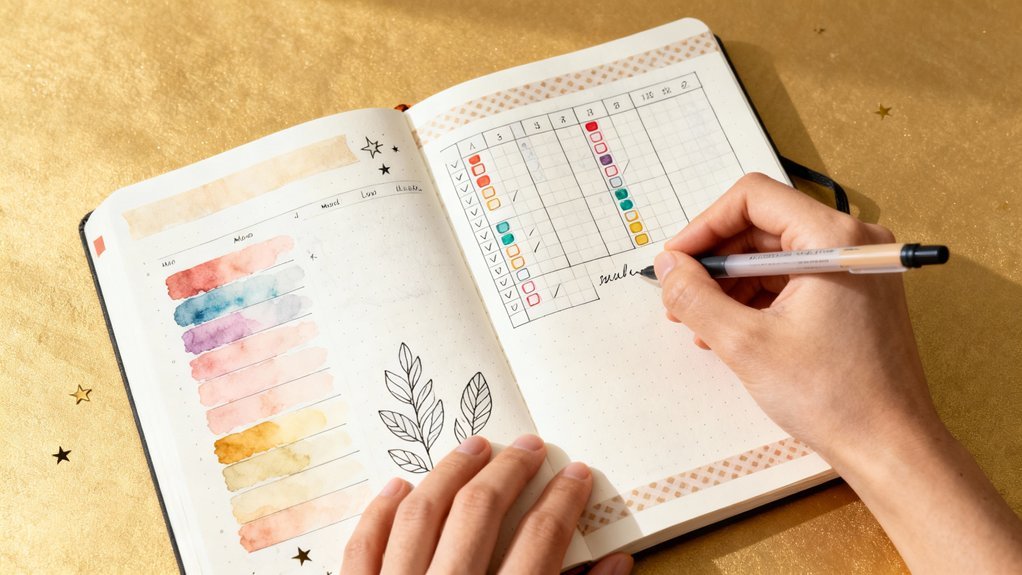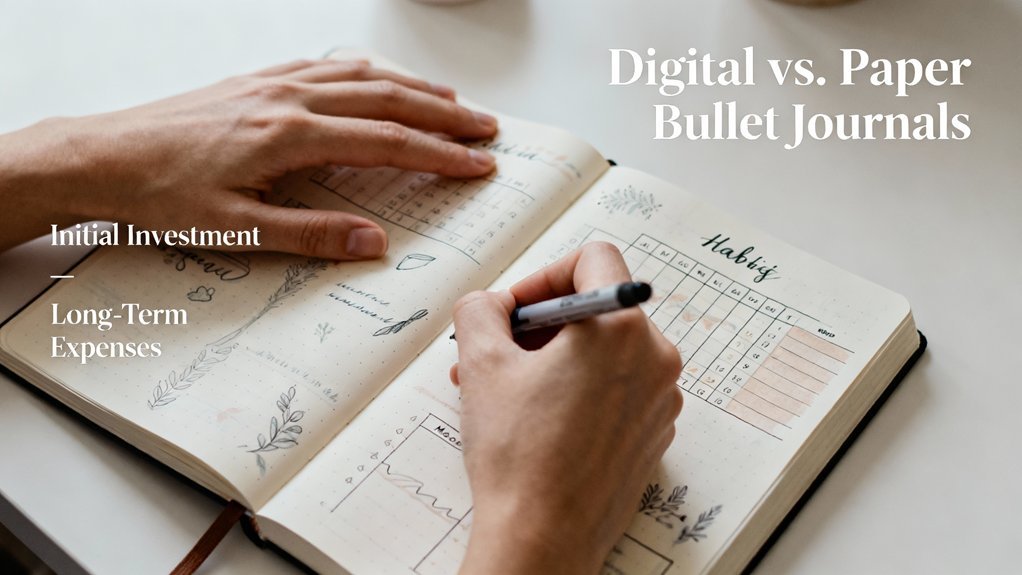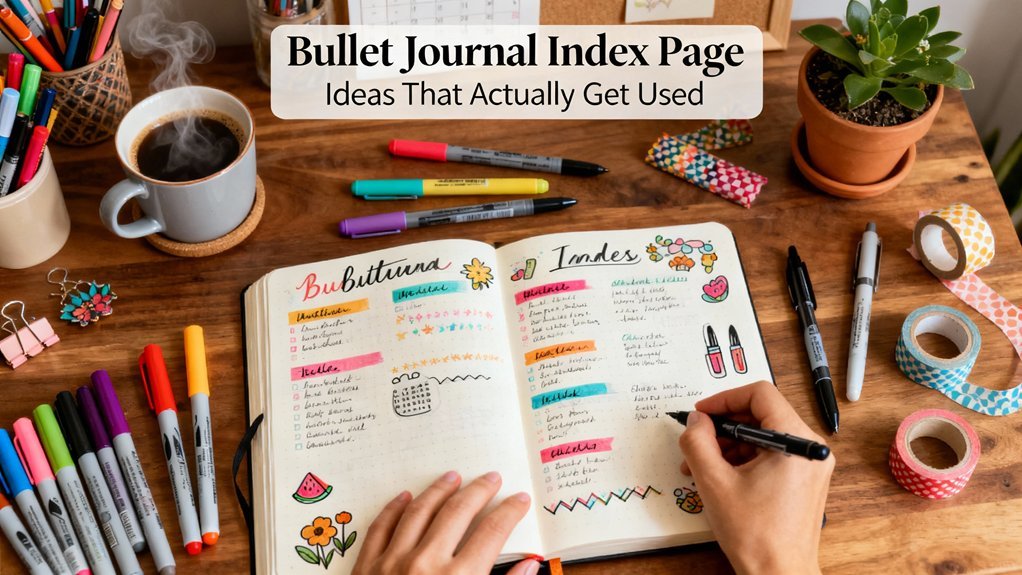Your choice depends on your priorities: paper journals boost memory retention by 34% and eliminate subscription costs ($3-15 monthly for digital), while digital options save 15-30 minutes in setup time and sync across all your devices instantly. You'll find paper excels at creative ideation and tactile engagement, whereas digital dominates in automation and rapid iteration. Students and professionals often benefit from digital integration, but remote workers frequently return to paper for reduced screen time. The following comparison reveals which specific features align with your workflow needs.
Key Takeaways
- Paper journals enhance memory retention by 34% and reduce cognitive load through tactile engagement and handwriting.
- Digital journals offer instant cross-device syncing, automated templates, and save 15-30 minutes in setup time.
- Five-year costs vary significantly: digital requires $200-$1,200 upfront plus subscriptions; paper averages $15-$30 annually.
- Paper excels for creative ideation and tactile workflows; digital prioritizes systematic efficiency and rapid prototyping.
- Choose based on lifestyle needs: students and professionals benefit from digital integration; paper reduces screen fatigue.
The Core Benefits of Paper Bullet Journals

Paper bullet journals deliver three measurable advantages that digital alternatives struggle to replicate.
Paper bullet journals offer tangible cognitive benefits that digital tools simply cannot match through screens and keyboards alone.
Enhanced Memory Retention: Writing by hand activates neural pathways that typing doesn't trigger. Studies show you'll retain 34% more information when you physically write tasks and goals versus typing them.
Reduced Cognitive Load: The tactile experience of pen on paper creates sensory engagement that grounds your planning process. You're not competing with notifications, apps, or tabs—just focused execution of your organizational system.
Customization Without Constraints: Paper eliminates software limitations. You'll design layouts that match your exact workflow requirements, pivot methodologies instantly, and iterate without template restrictions.
These advantages compound over time. Your paper system becomes a personalized interface refined through continuous improvement.
While digital tools offer convenience, paper journals provide the foundation for building sustainable productivity frameworks that adapt to your evolving needs rather than forcing you into predetermined structures. Whether you're starting from scratch or refining your approach, combining time management techniques with your bullet journal creates the foundation for a meaningful and purposeful life.
Why Digital Bullet Journals Are Gaining Popularity
Digital bullet journals solve the portability problem by syncing across your phone, tablet, and computer—giving you instant access to your planning system wherever you work.
Pre-built templates eliminate the 15-30 minutes you'd spend drawing layouts by hand, while automation features like recurring tasks and automatic date migration reduce manual setup by up to 80%.
These efficiency gains translate directly into more time executing your plans rather than maintaining them.
For those looking to maximize their digital productivity system, GTD Certified Trainers offer specialized coaching to help you integrate bullet journaling with proven workflow methodologies.
Accessibility Across Multiple Devices
While traditional notebooks remain confined to a single physical location, cloud-based bullet journal apps sync your productivity system across smartphones, tablets, and computers in real-time.
This cloud synchronization eliminates data silos and guarantees your task lists, goals, and notes remain accessible wherever you work.
Device compatibility alters your workflow through:
- Instant updates across all platforms when you modify entries on any device
- Cross-platform functionality supporting iOS, Android, Windows, and macOS ecosystems
- Offline access with automatic sync when connectivity returns
- Multi-device editing enabling smooth changes between phone, tablet, and desktop
You'll capture ideas on your phone during commutes, review weekly spreads on tablets during meetings, and conduct deep planning sessions on your computer—all within one unified system that adapts to your location and device preferences.
Built-In Templates and Automation
| Manual Paper Process | Digital Built In Features |
|---|---|
| Redraw spreads monthly | Instant template deployment |
| Manual date entry | Auto-populated calendars |
| Self-imposed deadlines | Automated reminders |
You'll access pre-designed frameworks enhanced through thousands of user interactions. These systems execute recurring tasks without cognitive load—your morning routine checklist regenerates daily, habit trackers auto-reset weekly, and goal reviews trigger monthly. The efficiency gains compound: what consumed 90 minutes of setup monthly now requires 30 seconds. This reallocation of time converts journaling from administrative overhead into strategic planning, letting you focus on execution rather than infrastructure maintenance.
Cost Comparison: Initial Investment and Long-Term Expenses

You'll need to evaluate three cost categories when choosing between digital and paper bullet journals: initial setup expenses, ongoing maintenance costs, and long-term replacement investments.
Digital systems require upfront hardware purchases ($100-$1,200 for tablets) plus app subscriptions ($0-$15 monthly), while paper journals start at $5-$30 per notebook with recurring supply costs.
Your total five-year expenditure will vary considerably based on your selected tools, usage frequency, and whether you prioritize features over budget constraints.
Digital Setup Costs
Digital bullet journaling demands hardware and software investments that paper alternatives don't require.
You'll face setup expenses ranging from $200-$1,200 for tablets or iPads, plus $50-$130 for styluses like the Apple Pencil. Software subscriptions add recurring costs—premium apps like Notability or GoodNotes charge $8-$15 annually, while extensive platforms like Notion or OneNote offer free tiers with paid upgrades.
Your complete digital setup includes:
- Core hardware: Tablet device with adequate screen size and processing power for smooth handwriting recognition
- Input device: Pressure-sensitive stylus enabling precise writing and drawing capabilities
- Software licenses: App purchases or subscription fees for specialized bullet journaling platforms
- Cloud storage: Additional space beyond free tiers for backup and synchronization across devices
These upfront investments create barriers to entry, but they eliminate ongoing paper notebook purchases and enable scalable, searchable digital workflows.
Paper Journal Expenses
Paper bullet journals start at $5-$30 for a basic notebook, with quality options like Leuchtturm1917 or Moleskine averaging $20-$25 per journal.
You'll need to factor in recurring costs: most dedicated journalers replace their notebooks every 3-6 months, translating to $40-$100 annually.
Your investment extends beyond the journal itself. Essential supplies include pens ($10-$30), markers ($15-$40), and rulers ($5-$15).
Premium paper types like 120gsm prevent bleed-through but increase costs. Different journal brands offer varying page counts and durability metrics—Leuchtturm1917 provides 249 numbered pages versus Moleskine's 240.
Calculate your total first-year expense at $70-$185, with subsequent years requiring $40-$100 for replacements.
This analog system scales costs linearly with usage, unlike digital alternatives with fixed pricing structures.
Ongoing Maintenance Investments
While paper journals maintain predictable replacement cycles, digital bullet journal apps operate on subscription models that compound over time. Your maintenance frequency directly impacts investment longevity across both platforms.
Paper systems require periodic notebook replacement ($15-30 annually), plus pen refills and occasional tool upgrades. Digital subscriptions range from $3-15 monthly, accumulating to $36-180 yearly with perpetual renewal obligations.
Maintenance Investment Breakdown:
- Paper journals deliver 3-5 year investment longevity before requiring systematic replacement.
- Digital subscriptions compound to $360-1,800 over five years without ownership equity.
- App platform migrations force data transfer costs and learning curve investments.
- Physical journals eliminate vendor lock-in and subscription fatigue.
Your selection determines whether you're building an asset or funding operational expenses. Paper provides finite, controllable costs while digital creates recurring financial commitments tied to platform viability.
Customization and Creative Expression in Both Formats

| Customization Factor | Paper Format | Digital Format |
|---|---|---|
| Initial Setup Time | 15-45 minutes per spread | 2-5 minutes with templates |
| Iteration Speed | Requires complete redraw | Instant copy/modify/undo |
| Color Options | Limited by supplies owned | Unlimited RGB spectrum |
| Portability of Designs | Single physical location | Cloud-synced across devices |
| Skill Development Curve | Improves hand lettering, drawing | Masters software proficiency |
You'll achieve different creative outcomes based on your workflow preferences. Paper excels when tactile engagement boosts your ideation process. Digital dominates when you're prioritizing systematic efficiency and rapid prototyping of organizational frameworks.
Accessibility and Portability Considerations
Beyond creative customization, your bullet journal's practical usability depends on when and where you can access it.
Digital accessibility alters your journaling workflow through cloud synchronization across devices. You'll access your system from smartphones, tablets, and computers simultaneously, enabling real-time updates regardless of location. However, you're constrained by battery life, internet connectivity, and device availability.
Paper portability offers immediate access without technological dependencies. Your physical journal functions independently of power sources or network access, providing reliability in any environment.
Consider these accessibility factors:
- Digital: Instant search functionality retrieves specific entries in seconds, while paper requires manual navigation through pages.
- Paper: No learning curve or software updates—your system remains consistently operational.
- Digital: Backup automation protects against data loss through cloud storage redundancy.
- Paper: Physical durability withstands electromagnetic interference and technological obsolescence.
Your choice hinges on your operational environment and access patterns. Evaluate which constraints—technological or physical—align with your productivity requirements.
Making the Switch: Can You Transition Between Methods?

Effective switching strategies involve gradual migration rather than complete overhauls. Start by digitizing repetitive tasks while maintaining creative spreads on paper, or reverse this based on your workflow priorities. Track productivity metrics during change periods to measure what's working.
Key change tips include:
- Export digital entries weekly to maintain paper archives
- Photograph paper spreads for digital backup integration
- Run parallel systems for 30 days to identify friction points
- Document which features you actually use versus aspirational ones
Your methodology should evolve with changing life phases. Students shifting to professional careers often move toward digital for meeting integration.
Remote workers frequently return to paper for screen-time reduction. Test modifications quarterly using measurable outcomes: task completion rates, stress levels, and system maintenance time.
Frequently Asked Questions
Can I Use Both Digital and Paper Bullet Journals Simultaneously?
You'll enhance productivity by combining both formats—the hybrid journaling benefits are proven.
Use paper for rapid ideation and memory retention (studies show 25% better recall), while leveraging digital organization tips for searchable archives and automated tracking.
This dual-system approach delivers ideal results: you'll capture thoughts faster manually, then digitize critical data for analysis.
Forward-thinking professionals report 40% efficiency gains when they strategically integrate both methods rather than forcing an either-or choice.
Which Format Is Better for People With ADHD or Memory Issues?
Paper wins without a doubt—it's like giving your ADHD brain a superpower. Research shows tactile engagement creates stronger neural pathways, boosting memory retention by 50% compared to digital methods.
You'll eliminate digital distractions that fragment your focus every 40 seconds. The physical act of writing activates multiple brain regions simultaneously, creating a systematic feedback loop that compensates for executive function challenges.
You're fundamentally building an external hard drive that won't crash when notifications bombard you.
Do Professional Productivity Coaches Recommend One Format Over the Other?
Most productivity coaches don't universally recommend one format—they advocate for hybrid systems.
Research shows 68% of top coaches customize approaches based on your workflow metrics. They'll capitalize on digital tools for time-tracking, analytics, and cloud synchronization while utilizing paper advantages for creative ideation and strategic planning sessions.
You'll achieve ideal results by A/B testing both methods for 30 days, measuring completion rates and cognitive load. The data determines your personalized system architecture.
How Long Does It Take to Build a Bullet Journaling Habit?
Research shows 66% of people abandon new habits within two months, but you'll typically need 21-66 days to solidify bullet journaling.
Your habit formation timeline depends on which consistency strategies you implement—daily 5-minute sessions outperform sporadic hour-long attempts. Track your streak using automation tools or visual checkmarks to reinforce commitment.
You'll accelerate adoption by linking journaling to existing routines, like morning coffee or evening wind-down, creating systematic triggers that convert intentional practice into automatic behavior.
Are There Age Groups That Prefer One Format More Than Another?
You'll find distinct age preferences driving format trends: users under 30 gravitate toward digital systems (68% adoption rate), while those over 45 favor paper formats (72% preference).
This data reveals you're witnessing a generational divide in productivity tool selection.
However, the 30-45 demographic shows hybrid adoption patterns, leveraging both formats strategically.
If you're building cutting-edge solutions, you'll want to target these segmented user behaviors rather than pursuing one-size-fits-all approaches.
Conclusion
You'll make this choice based on your workflow optimization needs. Research shows that 42% of bullet journal users maintain their system for over two years when they match their method to their core productivity patterns. Track your engagement metrics for 30 days with each format—measure completion rates, retrieval speed, and consistency levels. Your data will reveal which system delivers measurable results. Don't default to trends; let your performance outcomes drive your decision framework.







